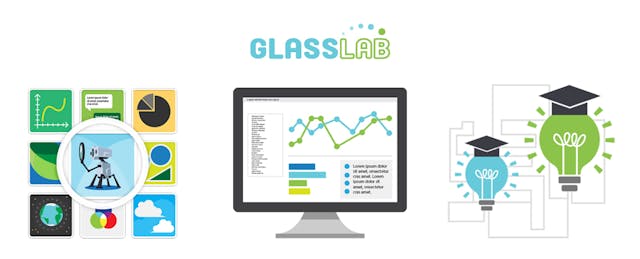No one questions that well-designed games can engage children, and a growing number of teachers are introducing them in their classrooms.
But skeptics abound when it comes to games’ impact on learning outcomes. Are the flurry of split-second decisions that a player makes in, say, a game like StarCraft translatable to real-world skills?
Jessica Lindl believe she has the tools to measure it. As Executive Director of GlassLab Games (“Glass” stands for games, learning and assessment), a nonprofit located on the Electronic Arts campus in Redwood City, Calif., she and her team have been building games that serve as formative assessments for critical thinking skills.
In 2013, GlassLab released “SimCityEDU,” a modified version of the popular franchise designed to be used in the classroom. (Here’s my review.) This year, it launched “Mars Generation One: Argubot Academy,” where players make decisions regarding the colonization of Mars.
Both games address Common Core English Language Arts standards around making evidence-based claims, along with Next Generation Science Standards and 21st century skills. An early study conducted by Education Testing Service, Pearson and GlassLab of students who played “Mars Generation One” found “statistically significant improvements in argumentation as measured on external pre-post tests.”
Sharing the Engine
Building the assessment, analytics and reporting engine was no small feat. “There was an enormous amount of effort to actually pull the data from gameplay, apply it to an assessment model, and provide an actionable reporting dashboard for teachers,” says Lindl. GlassLab’s games offer teachers access to two kinds of reports: one that shows how students are performing on the standards, and another that flags struggling students.
To spare other developers from replicating such efforts, GlassLab is making this engine available to them as part of a platform called GlassLab Services. “This is a big opportunity for us to create a set of services that could power hundreds of games in the market and create that continuous assessment throughout the gameplay,” she adds.
It’s a boon for small developers like iCivics, the first of six beta partners working with GlassLab Services. With a team of just seven full-time employees, the nonprofit is integrating the assessment engine for “Argument Wars,” a game where students argue landmark Supreme Court cases using arguments and evidence for support.
“We were struggling with how to structure [gameplay] data in a simple way for teachers to be able to understand how to best drive instruction for each individual child,” explains Louise Dube, Executive Director of iCivics.
Jesse Schell, CEO of Schell Games, agrees: “Teachers, administrators, and parents are all interested in reports about what students who play educational games have learned and achieved. But making these interfaces is a lot of work. Having a standardized system for these reports is a great help for some kinds of games.” His team is working with GlassLab for “Water Bears,” a puzzler that introduces kids to the concept of systems thinking.
Other beta partners include BrainQuake (developer of “Wuzzit Trouble,” a math game), The Learning Games Lab at New Mexico State University (“Game Over Gopher,” a game about math coordinates), Ululab (“Slice Fractions”) and GameDesk (“Warp Driver,” a golf game about physics.)
GlassLab also plans to adapt its analytics engine to mainstream commercial games. Lindl says the team is working with an Electronic Arts title “that we are not modding at all” to test whether the problem-solving skills required in the game can be tied to specific learning outcomes.
Full ‘Steam’ Ahead
Proof of efficacy, however, does not translate to success in an education market saturated with games that make similar bold claims. As Alan Gershenfeld, President of E-Line Media, a publisher of learning games, has pointed out, many titles fall into a “valley of insufficiency” where they struggle to “rise above the noise in the consumer space.”
“To put it bluntly,” says Schell, “there is a lot of junk in the educational games market.” Lindl adds: “There’s no proven path for how games with high learning impact can go to market.”
To this end, GlassLab Services also aspires to be a distribution portal for its partners. Citing popular game distribution platforms like Valve’s STEAM or Electronic Art’s Origin as examples, Lindl says GlassLab will serve as an online portal where developers can publish learning games that parents and educators can search for by filters like learning standards, grade level and reviews from peers.

For games published on this network, GlassLab has partnered with Clever to provide account management and provisioning services to so that teachers and students can manage accounts with a single login credential. Lindl says it’s working on similar integrations with Edmodo and Google.
Getting Down to Business
GlassLab was launched in 2012 thanks to a three-year, $10.2 million grant from the Gates Foundation and MacArthur Foundation. Now, says Lindl, her team has to prove that it can commercialize its research. “We’re now in the process of revenue generation from our game and our technology services.”
Eleven games will be available on GlassLab by summer 2015. At that time, GlassLab will invite other developers interested in using its services. (Here’s the software development kit.) In addition to taking a share of revenues from games sold on its platform, GlassLab also offers game and design assessment services for a fee.
Lindl says students and teachers in over 1,500 schools are playing GlassLab games--and that’s without any concerted marketing efforts. “Teachers and administrators are gamers themselves,” she observes, “and they certainly don’t think that playing games means you’re not learning.”
Dube believes her fellow developers ought to be excited at the prospect. “As game developers, we need to understand how the data can make inferences about what kids know or don’t know,” she explains. “It’ll make us rethink how we design our games.”


